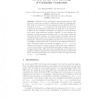Free Online Productivity Tools
i2Speak
i2Symbol
i2OCR
iTex2Img
iWeb2Print
iWeb2Shot
i2Type
iPdf2Split
iPdf2Merge
i2Bopomofo
i2Arabic
i2Style
i2Image
i2PDF
iLatex2Rtf
Sci2ools
CP
2007
Springer
2007
Springer
Towards Robust CNF Encodings of Cardinality Constraints
Motivated by the performance improvements made to SAT solvers in recent years, a number of different encodings of constraints into SAT have been proposed. Concrete examples are the different SAT encodings for ≤ 1 (x1, . . . , xn) constraints. The most widely used encoding is known as the pairwise encoding, which is quadratic in the number of variables in the constraint. Alternative encodings are in general linear, and require using additional auxiliary variables. In most settings, the pairwise encoding performs acceptably well, but can require unacceptably large Boolean formulas. In contrast, linear encodings yield much smaller Boolean formulas, but in practice SAT solvers often perform unpredictably. This lack of predictability is mostly due to the large number of auxiliary variables that need to be added to the resulting Boolean formula. This paper studies one specific encoding for ≤ 1 (x1, . . . , xn) constraints, and shows how a state-of-the-art SAT solver can be adapted to ...
Related Content
| Added | 07 Jun 2010 |
| Updated | 07 Jun 2010 |
| Type | Conference |
| Year | 2007 |
| Where | CP |
| Authors | João P. Marques Silva, Inês Lynce |
Comments (0)

